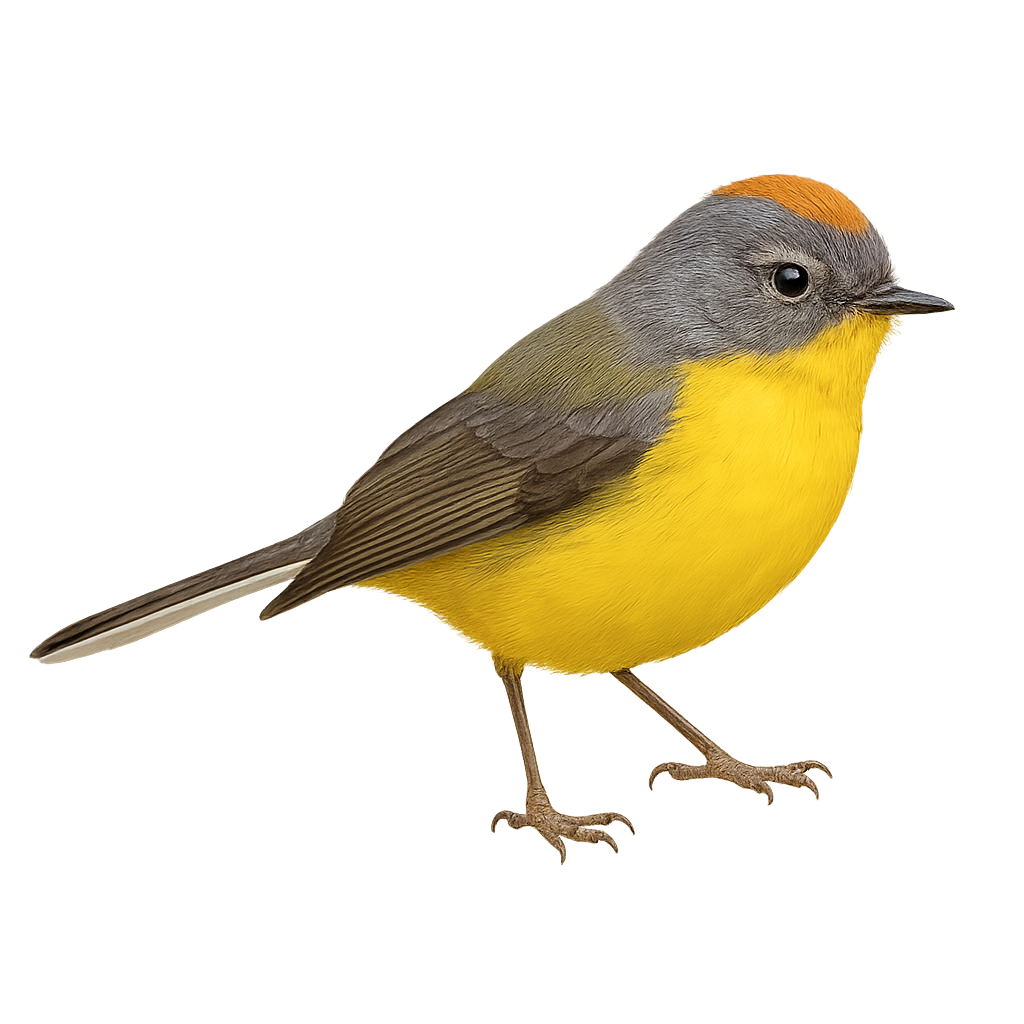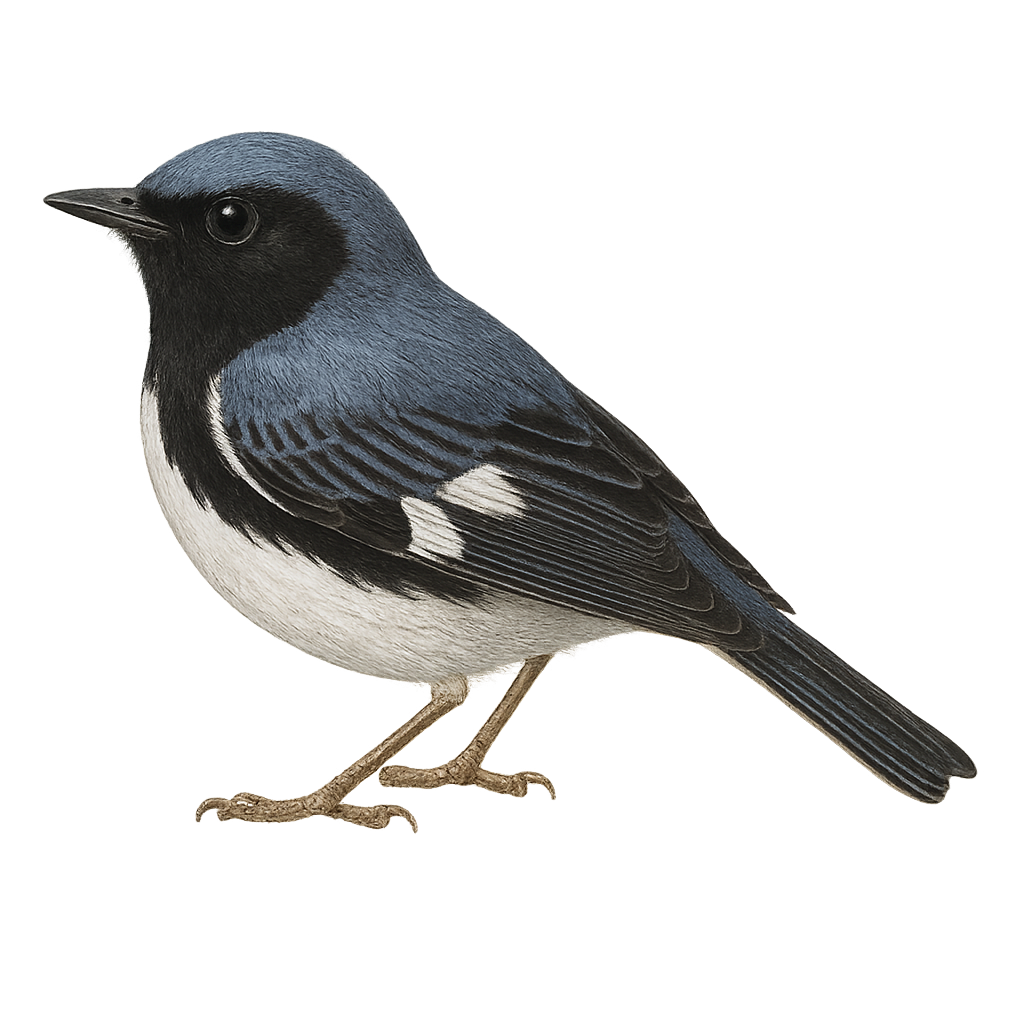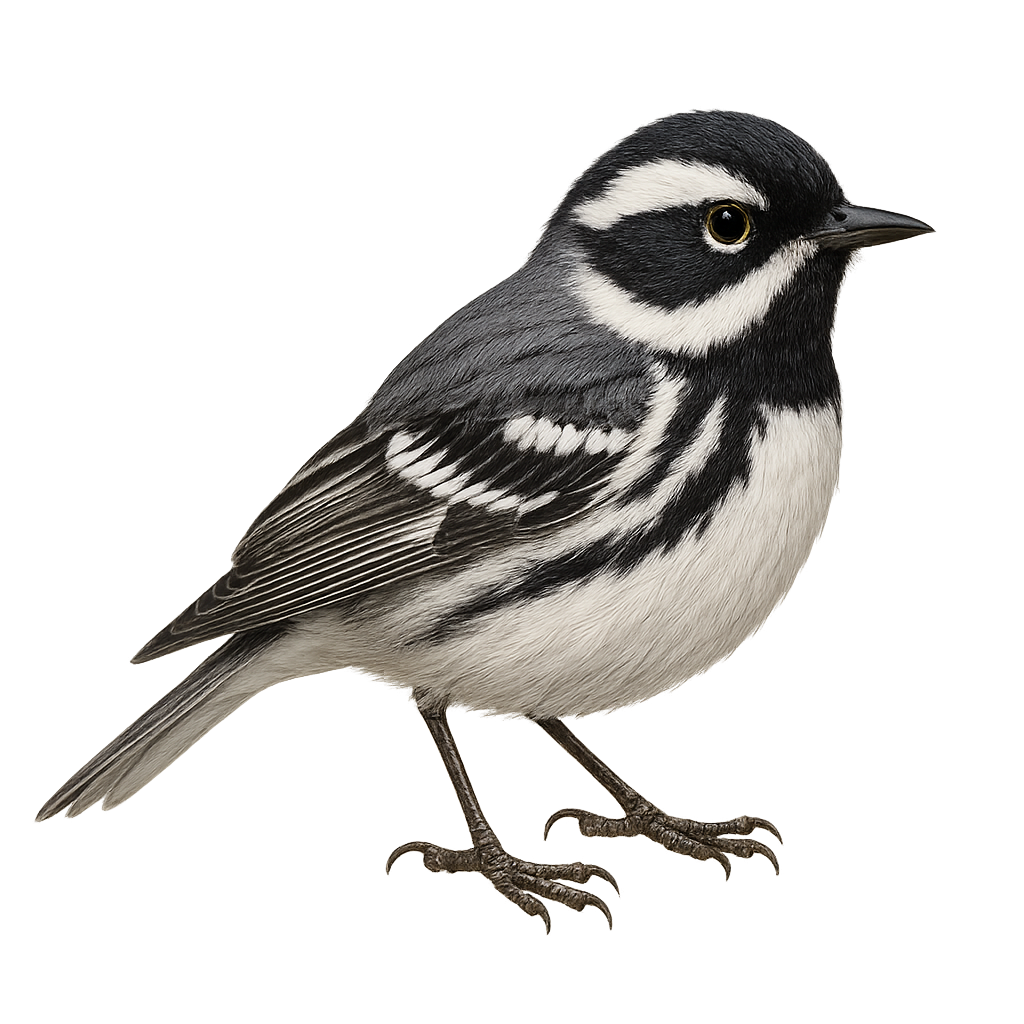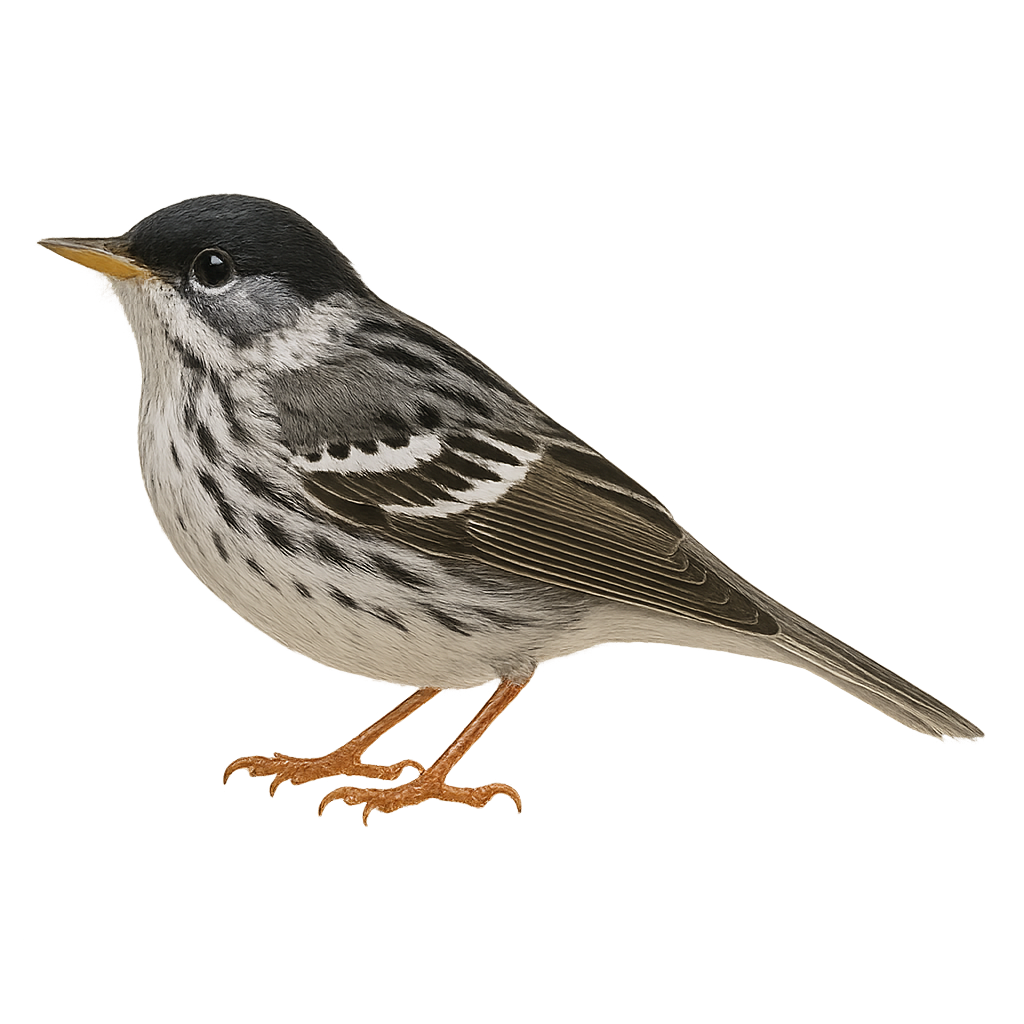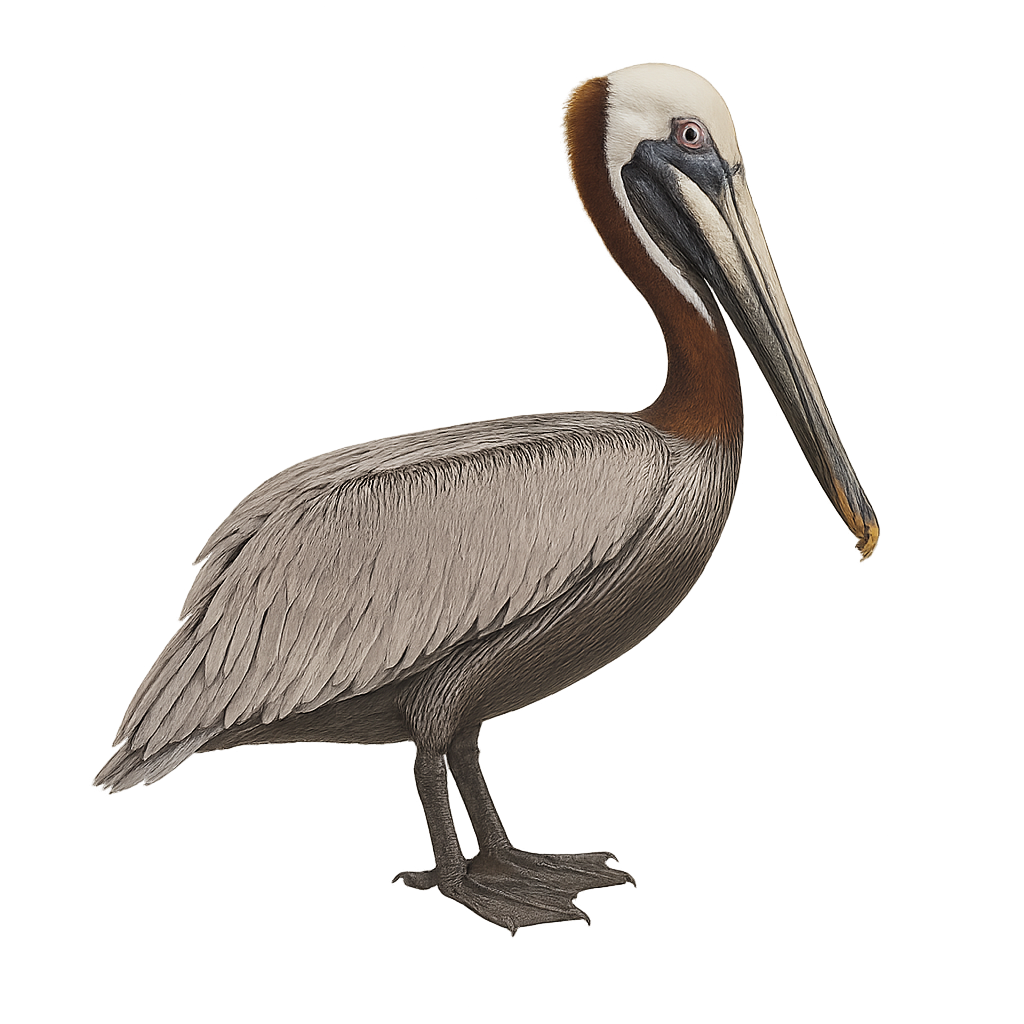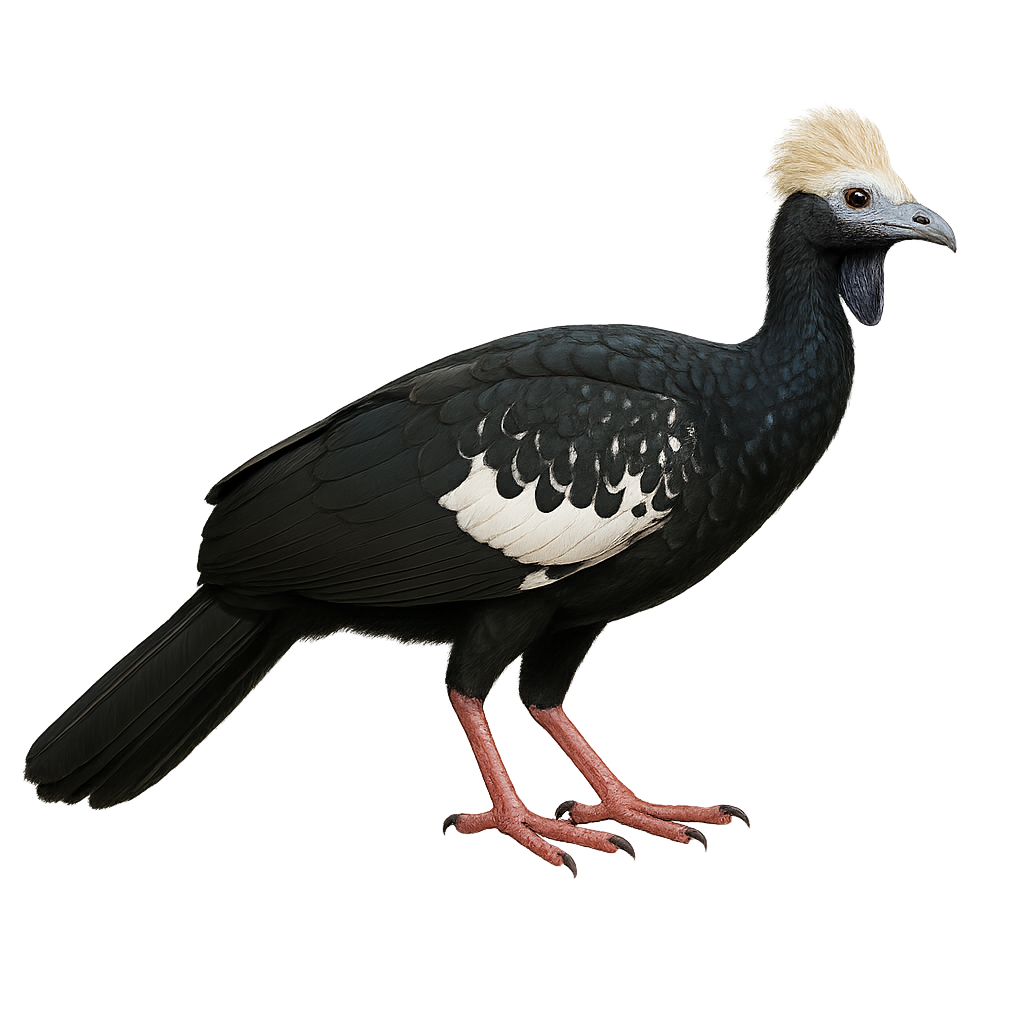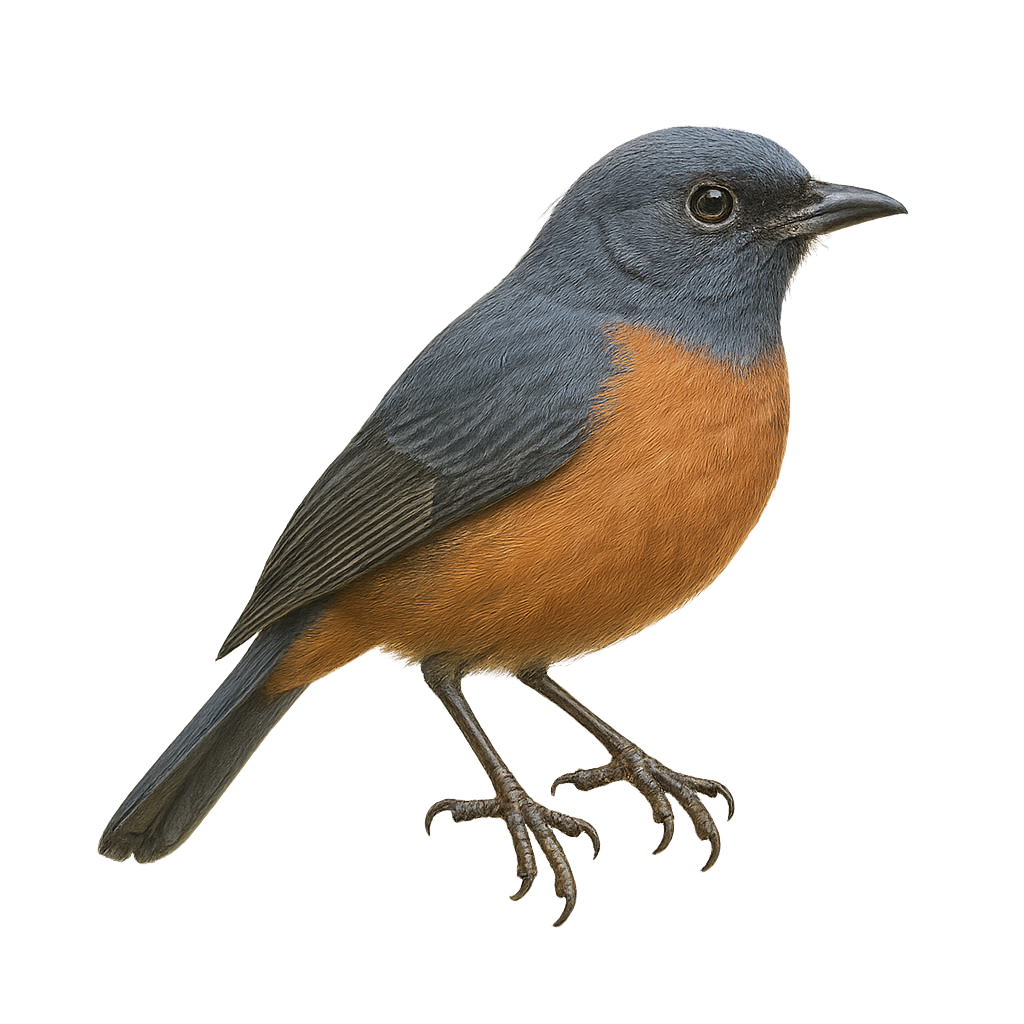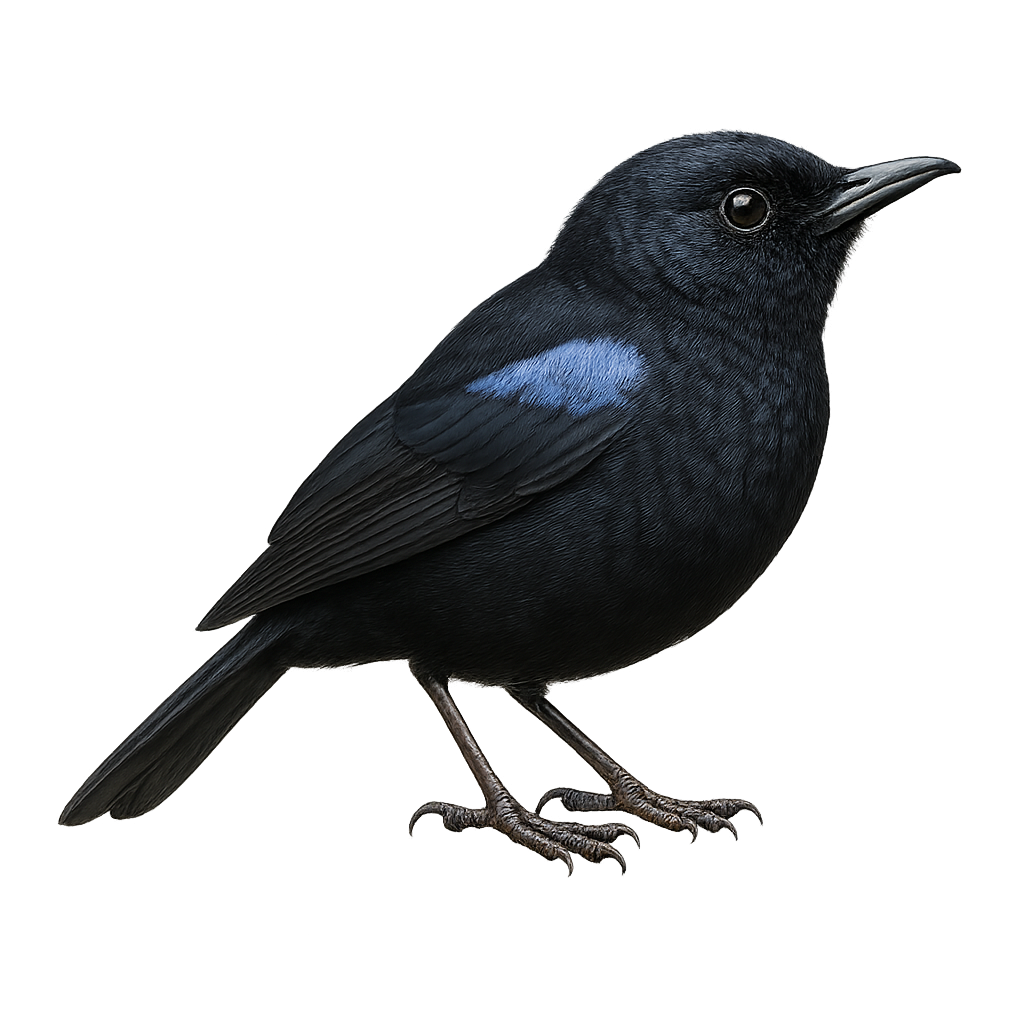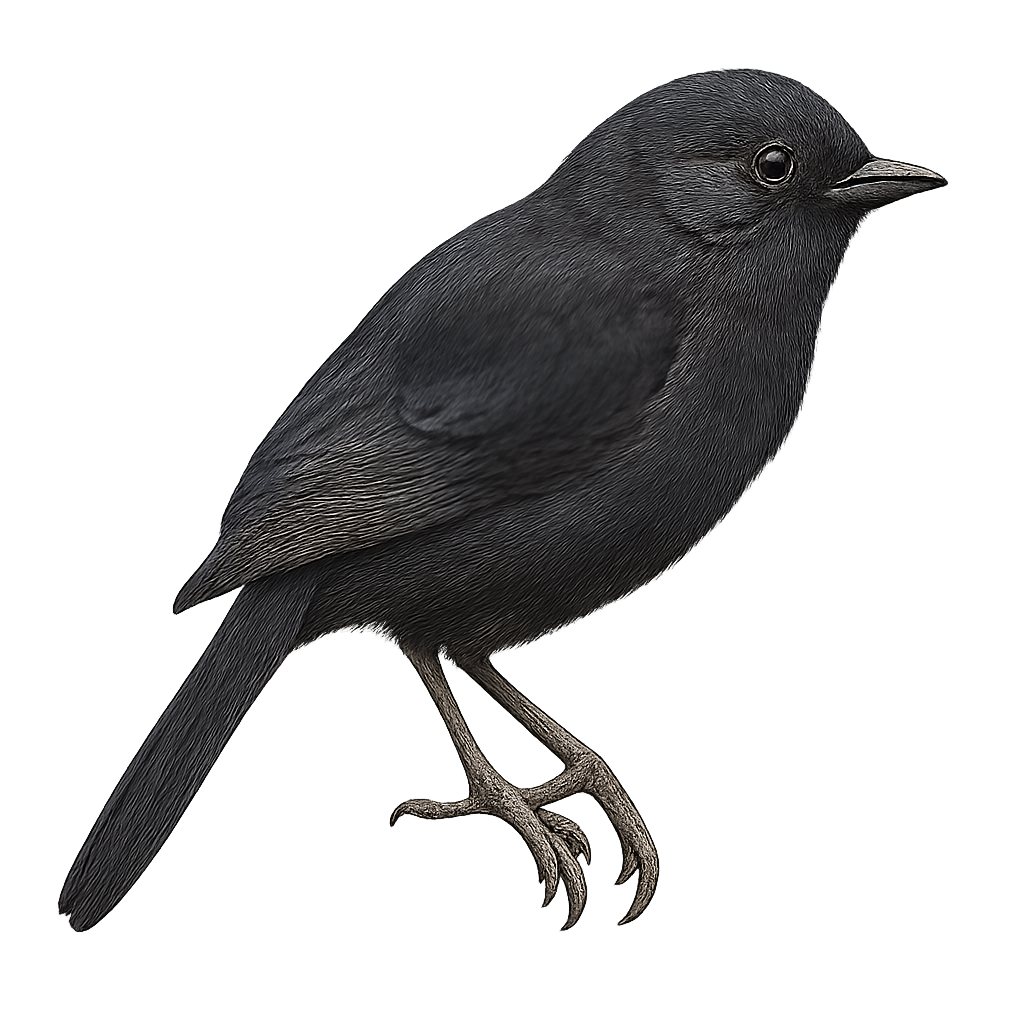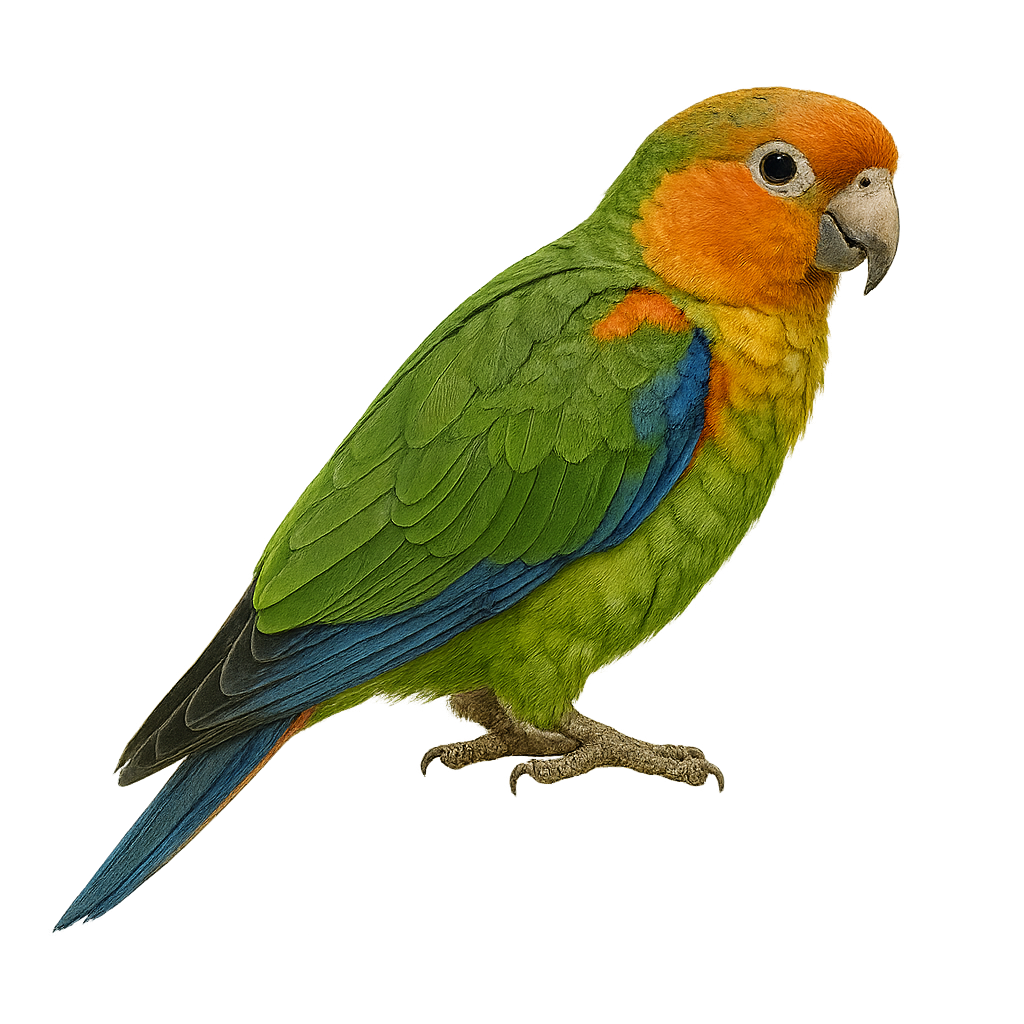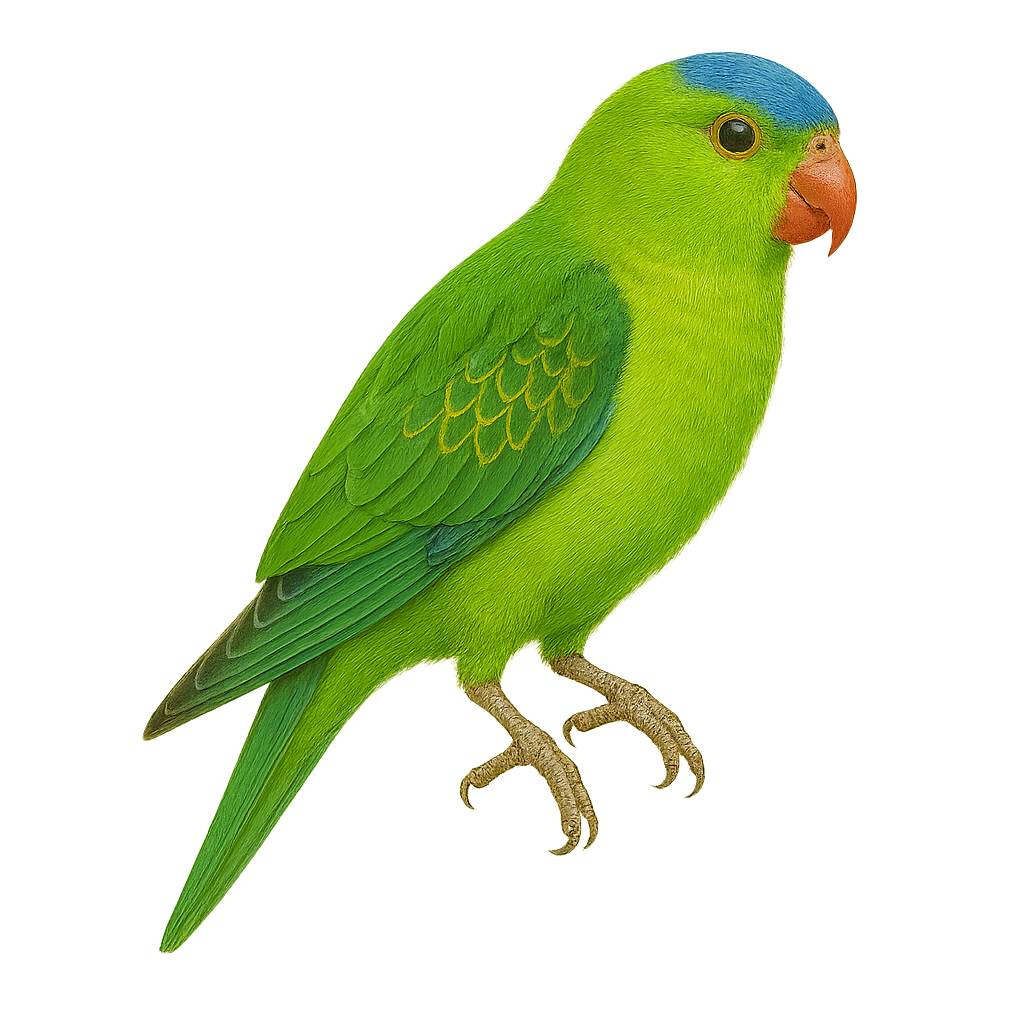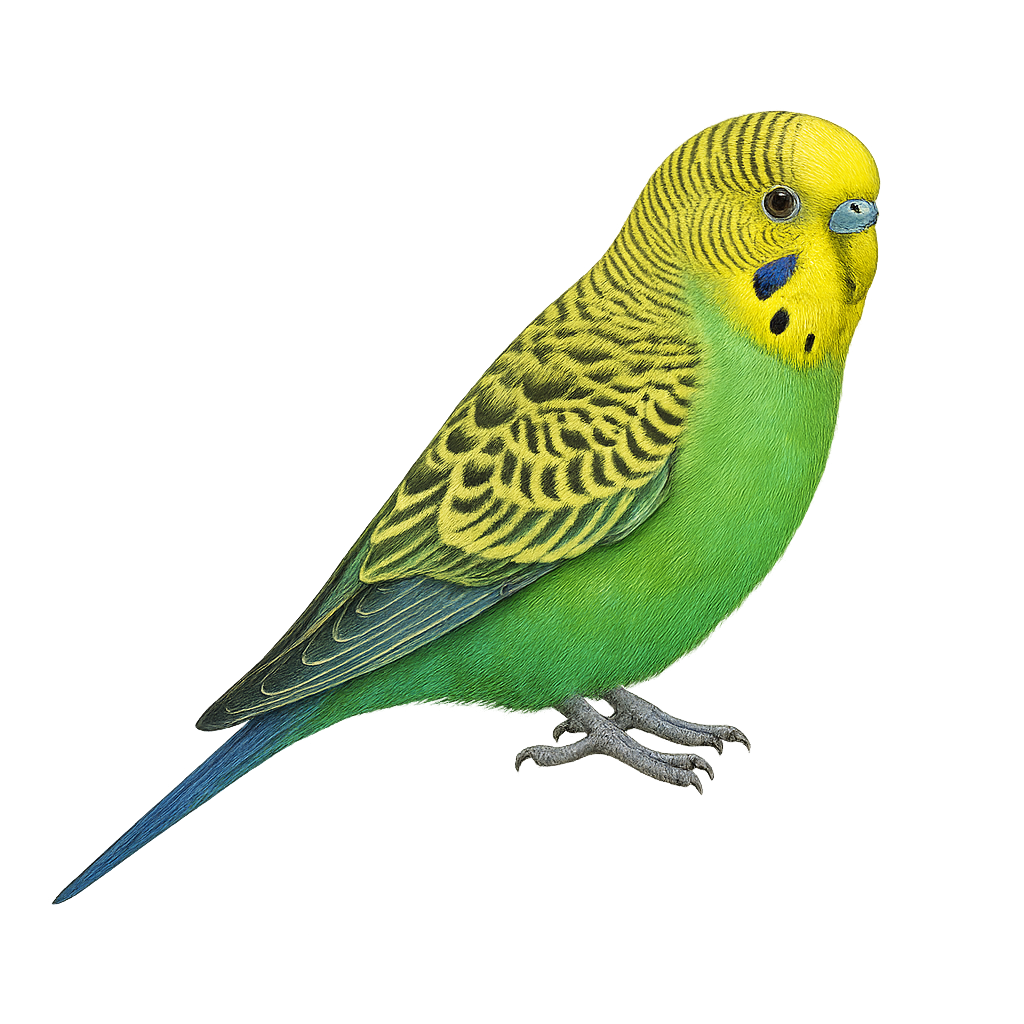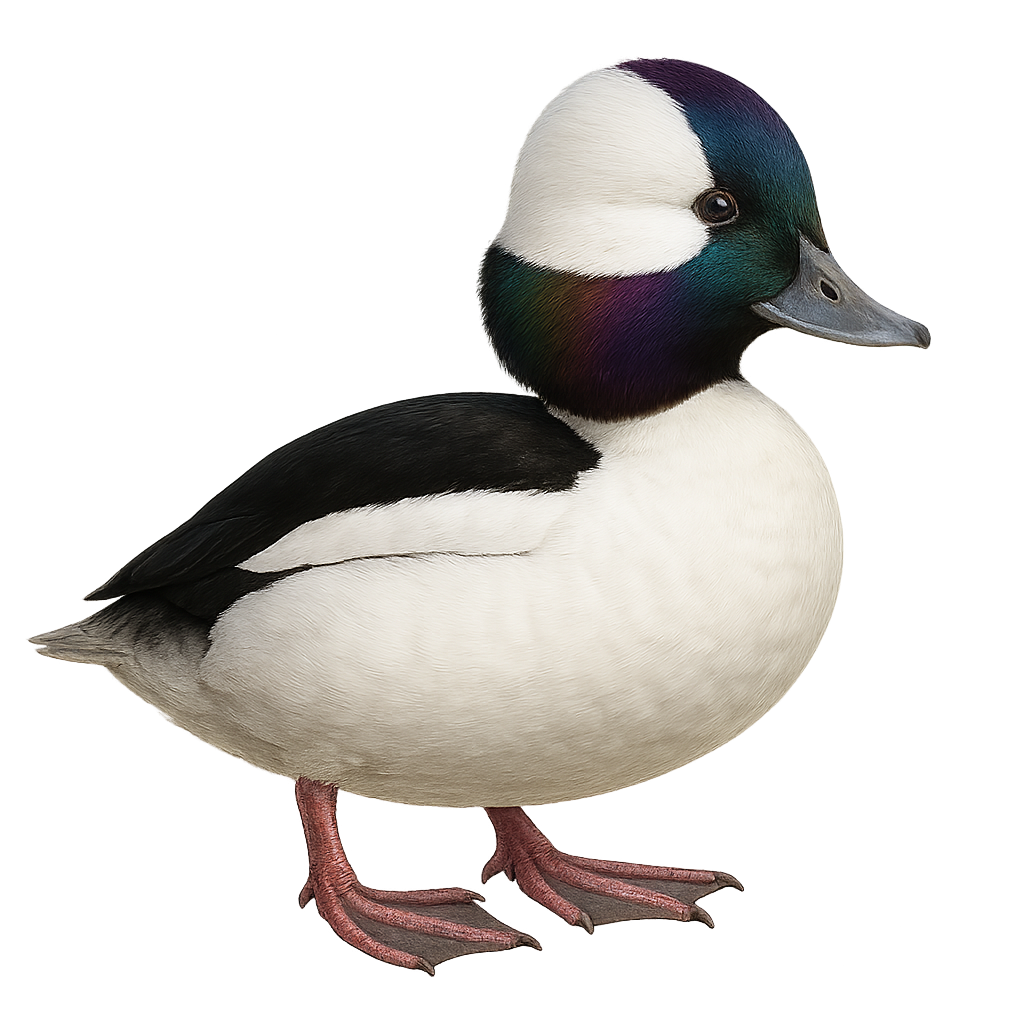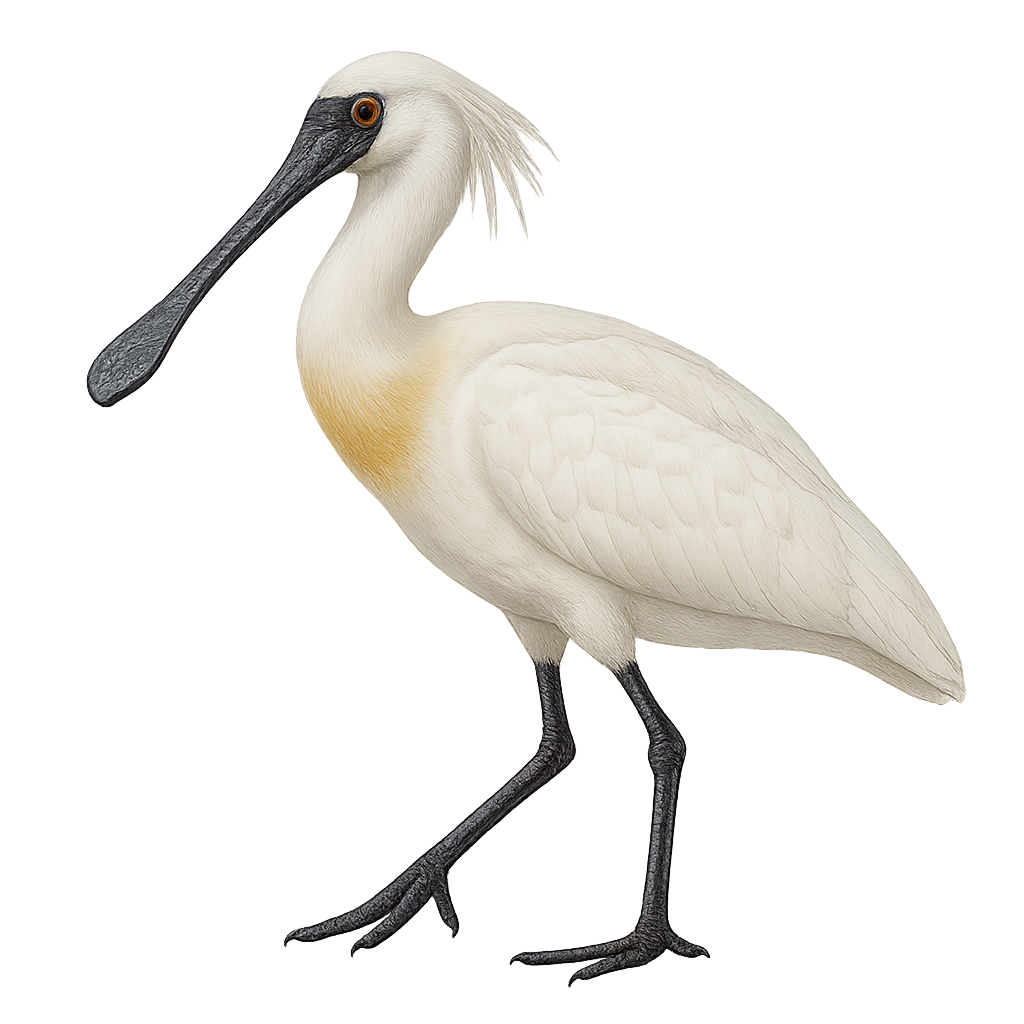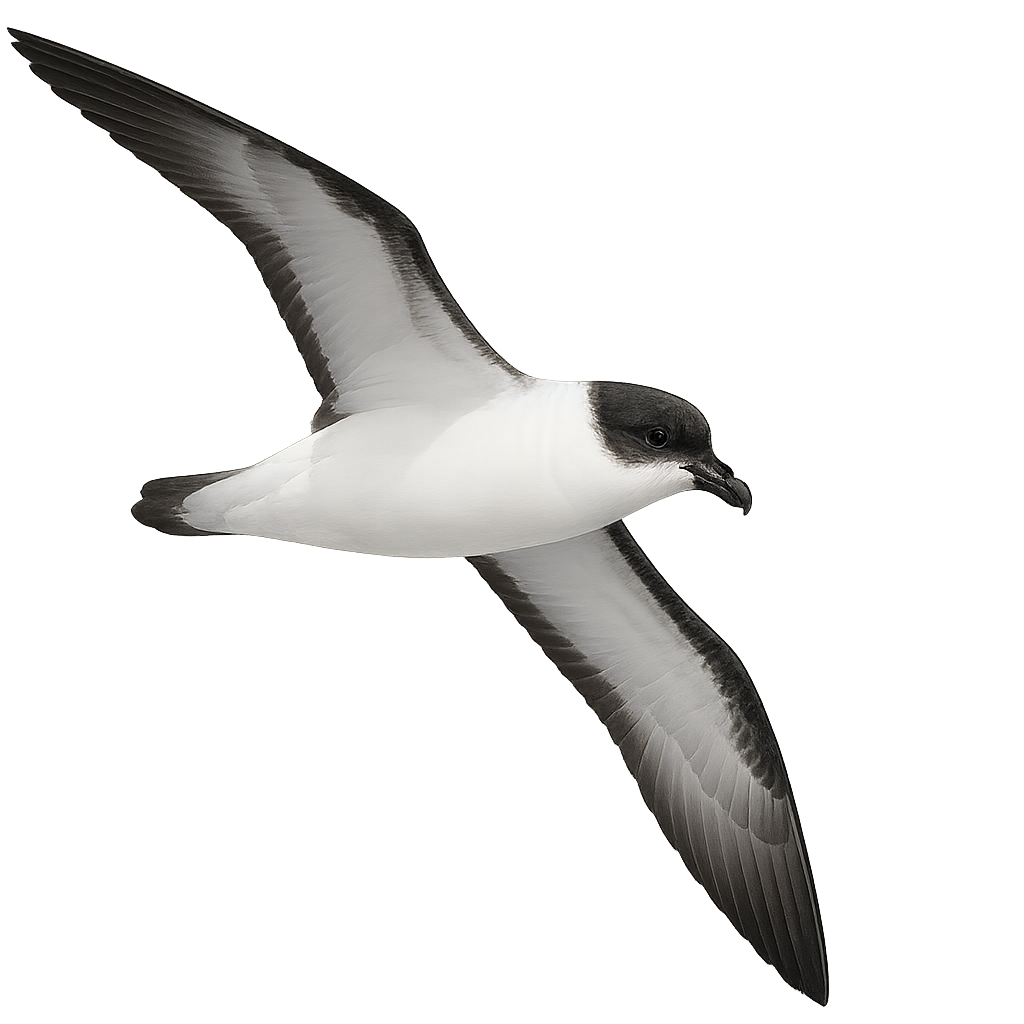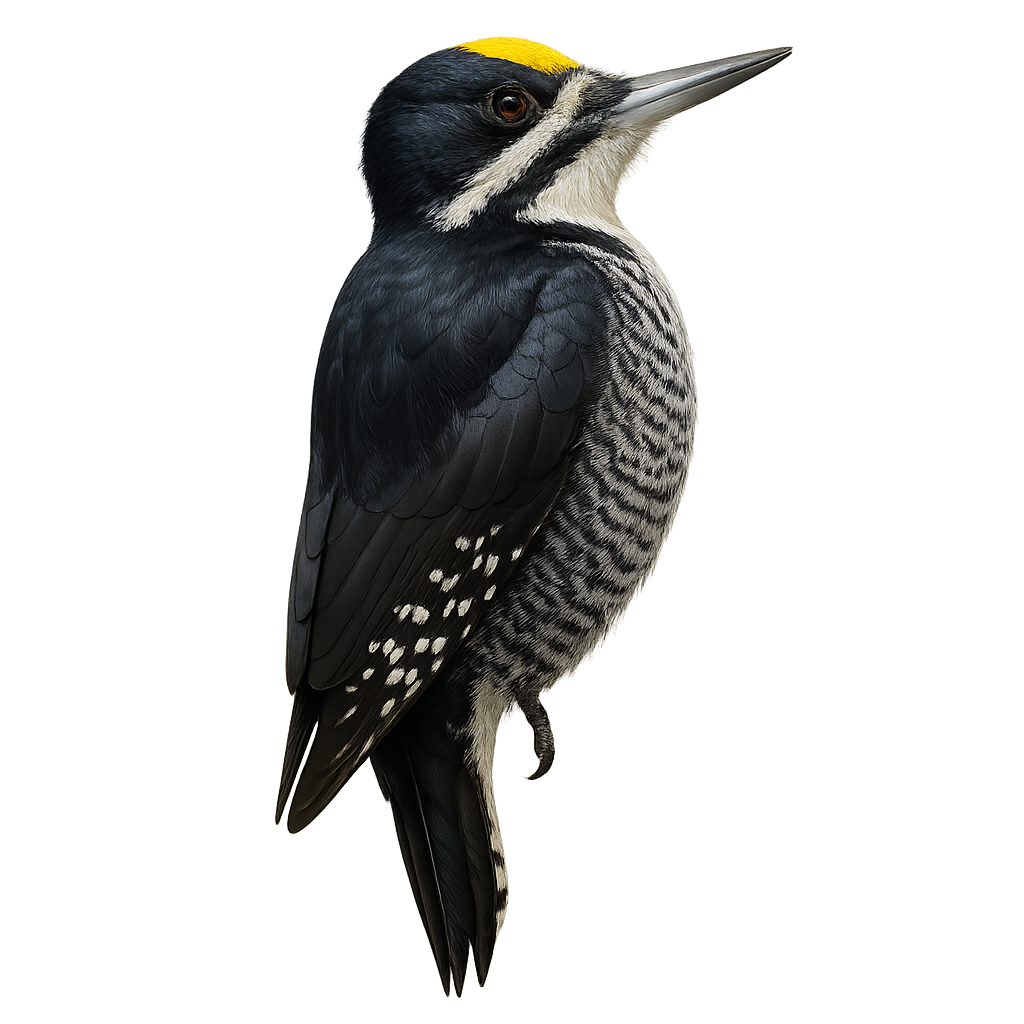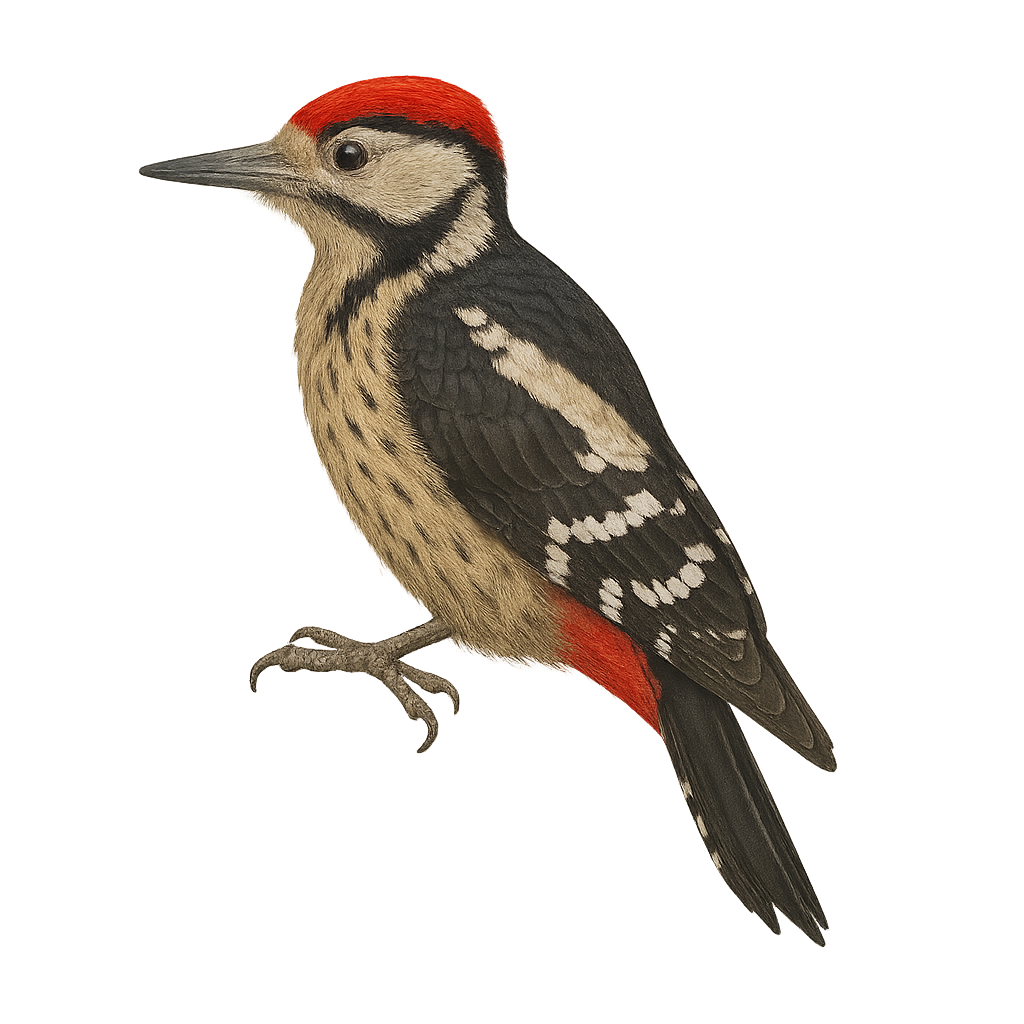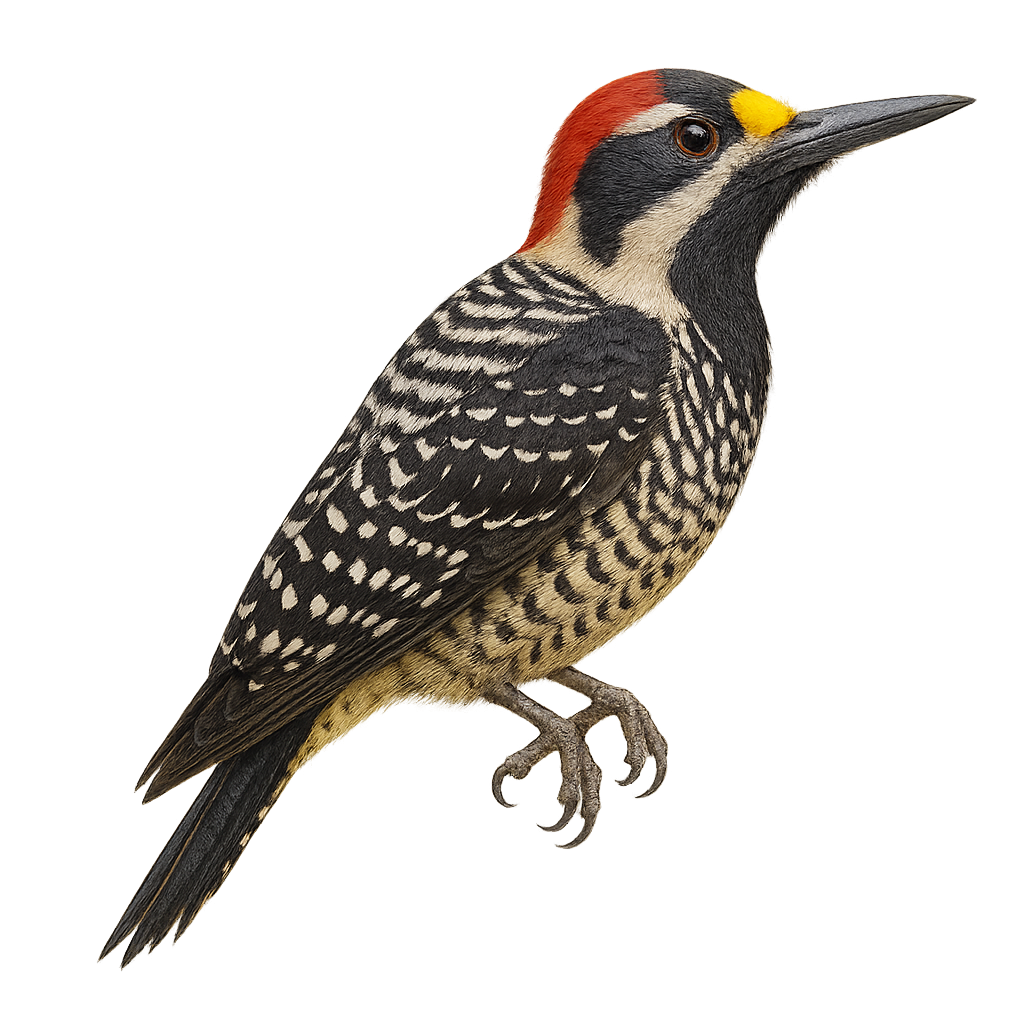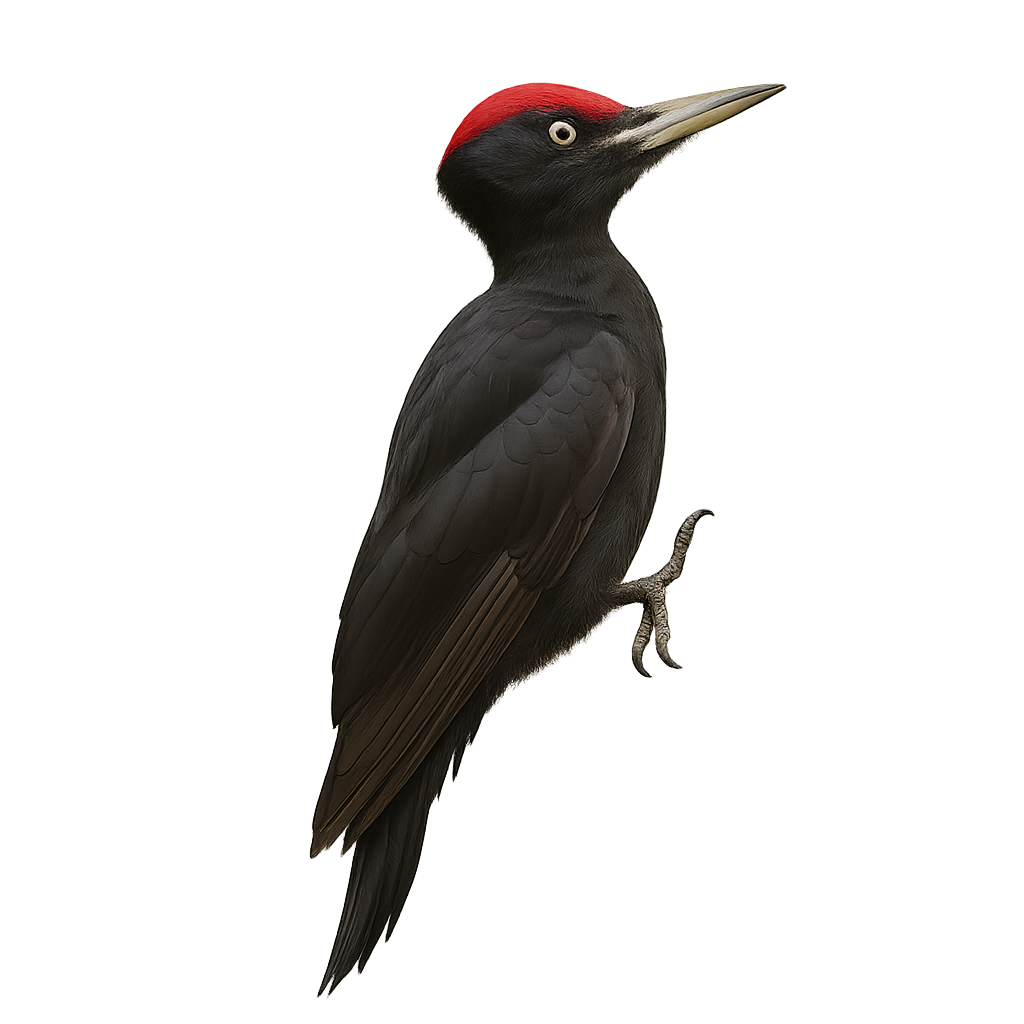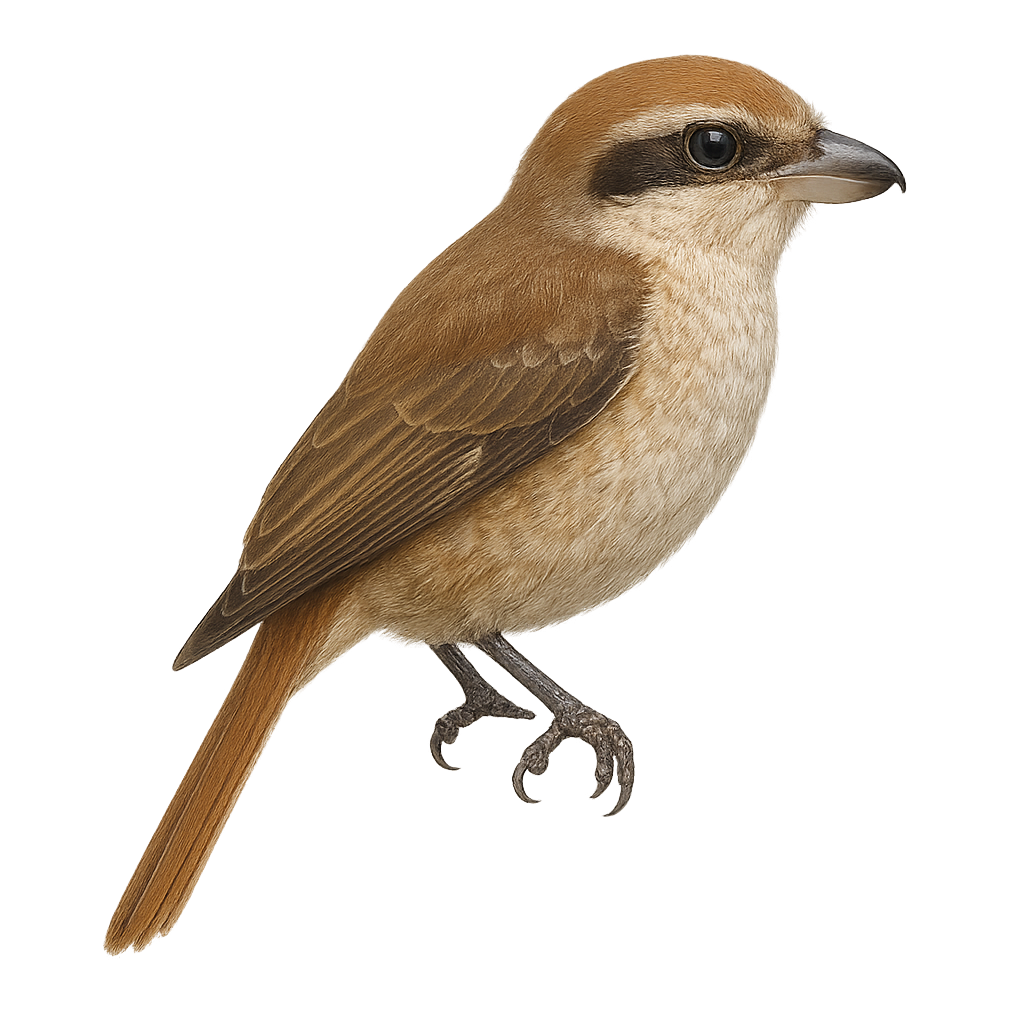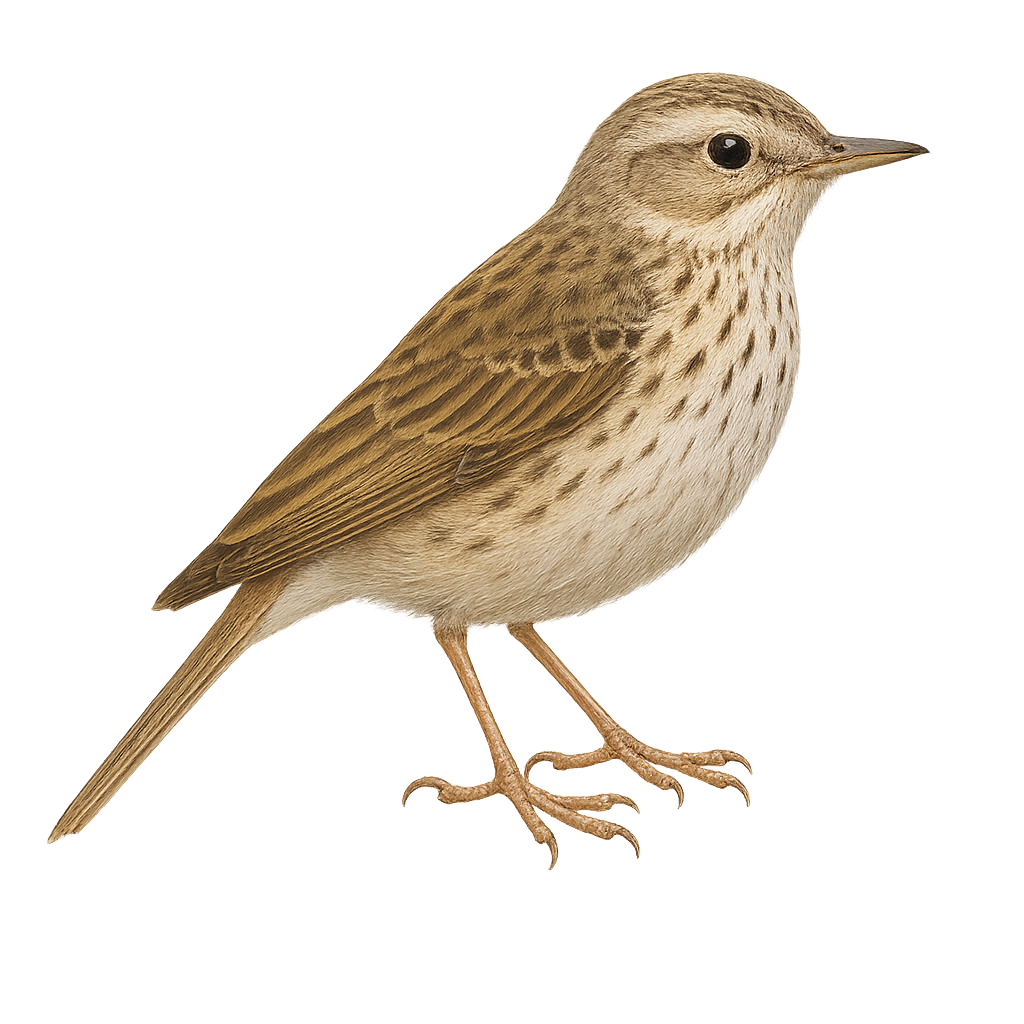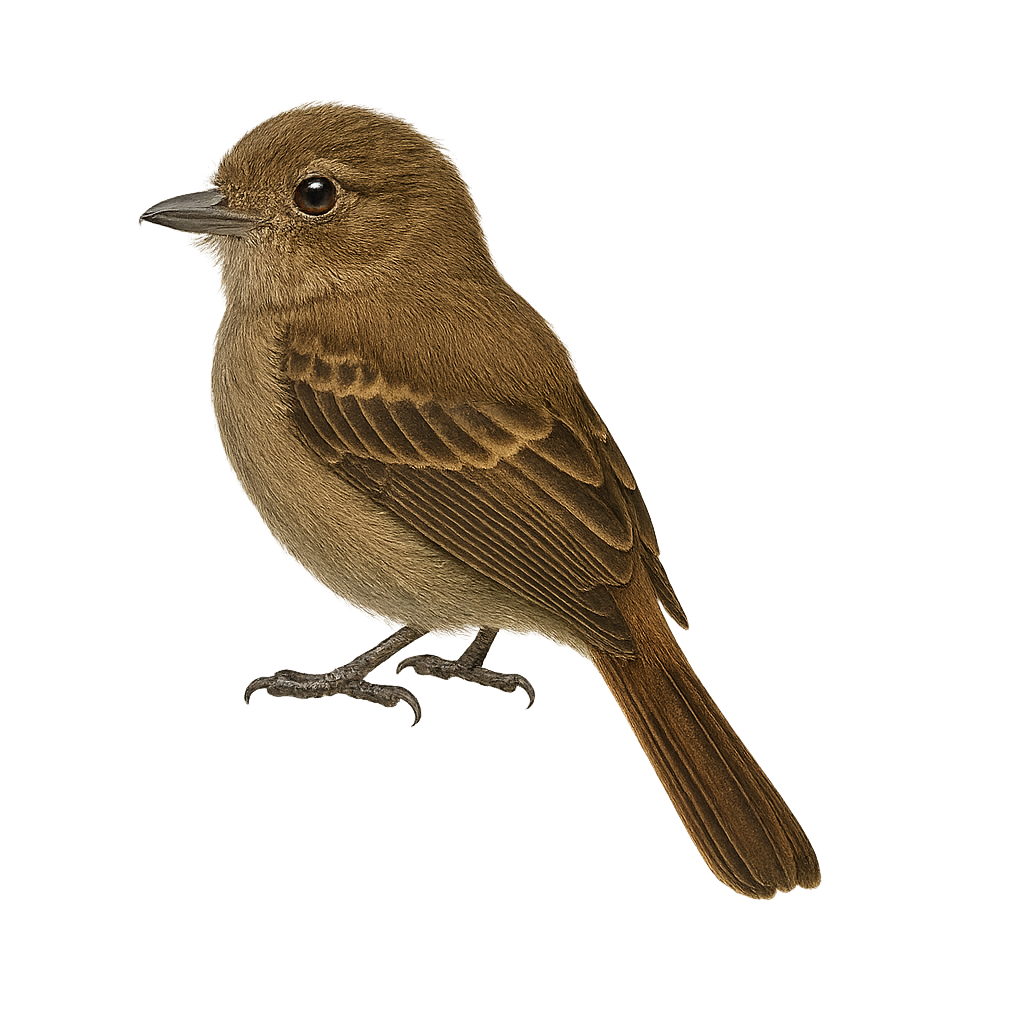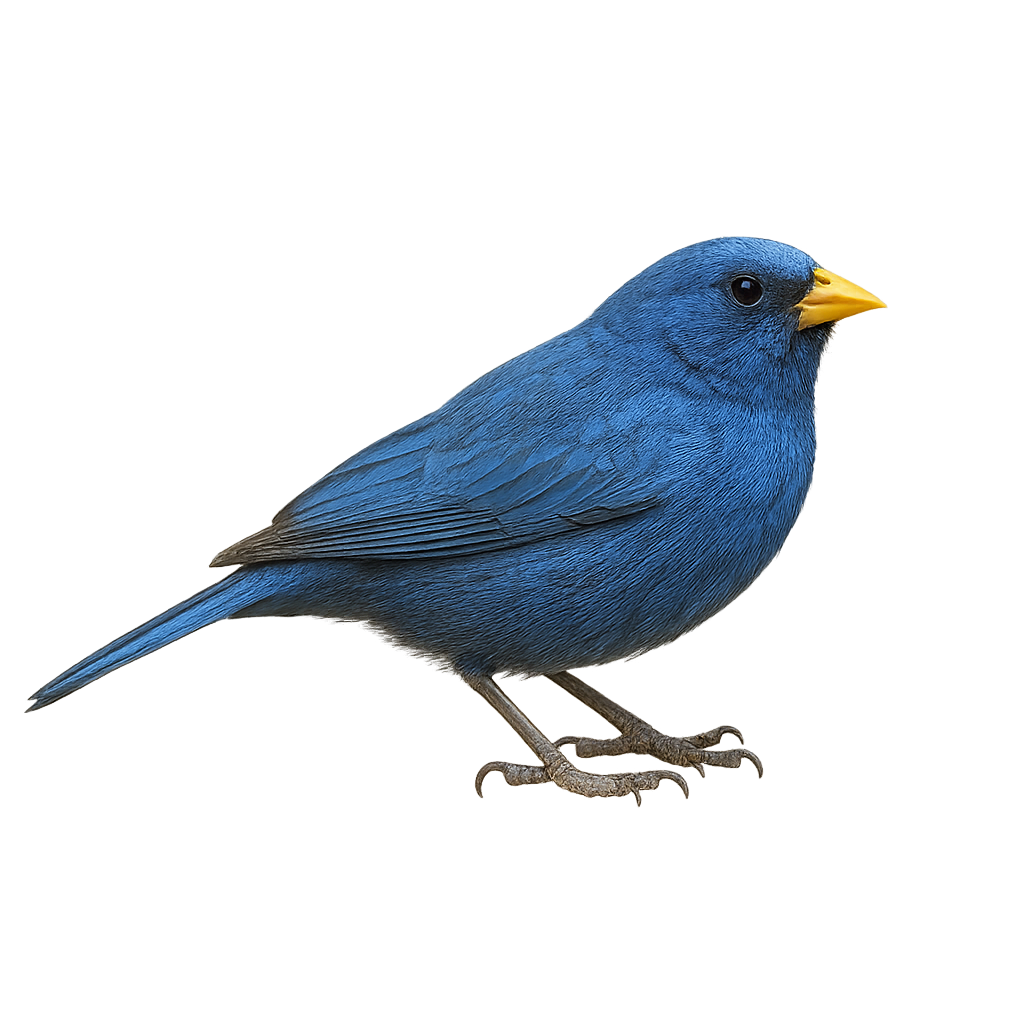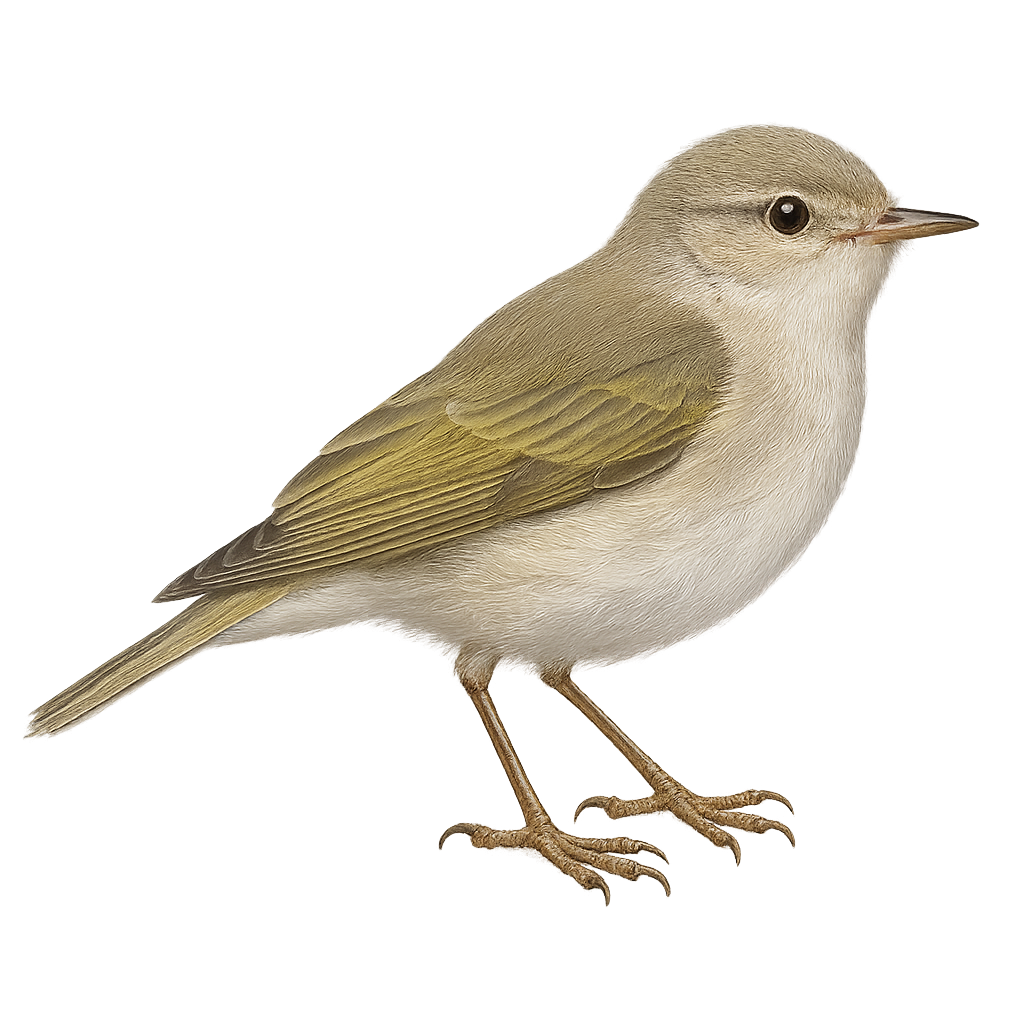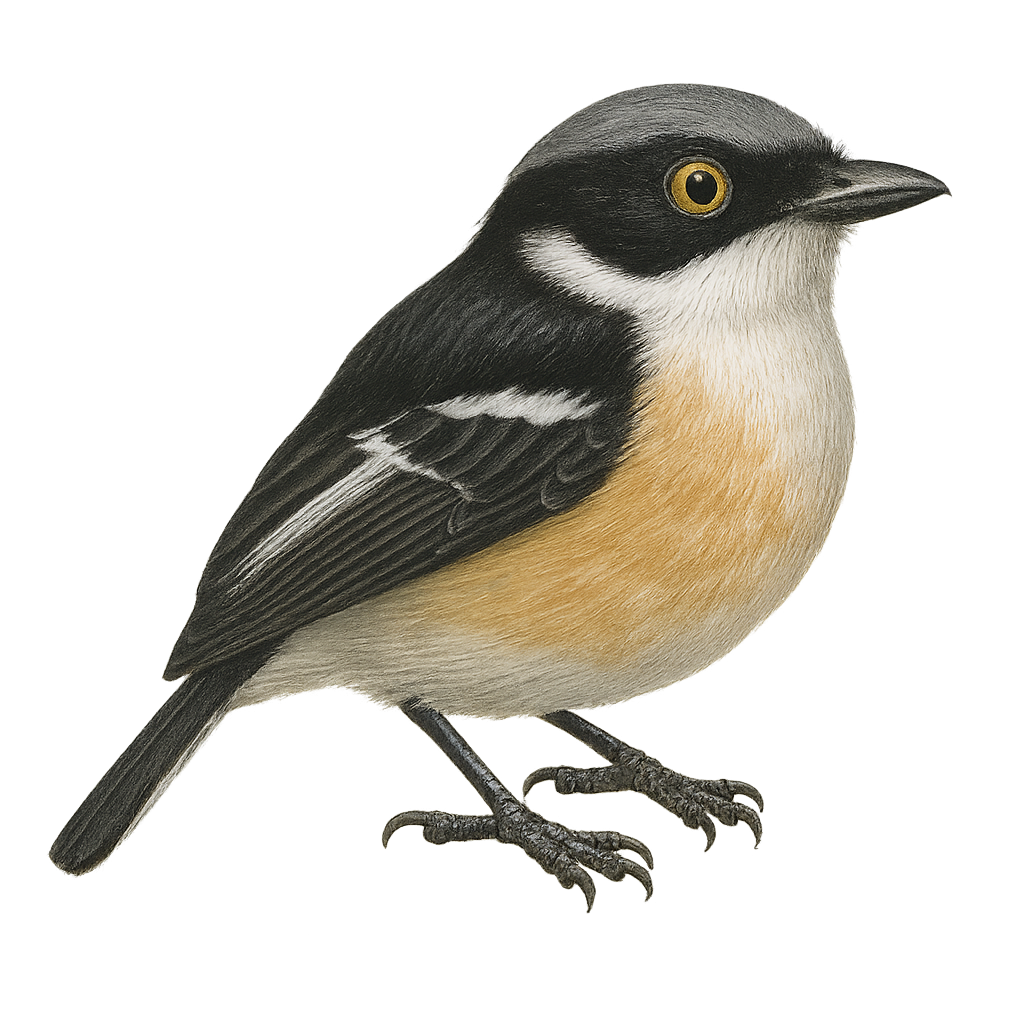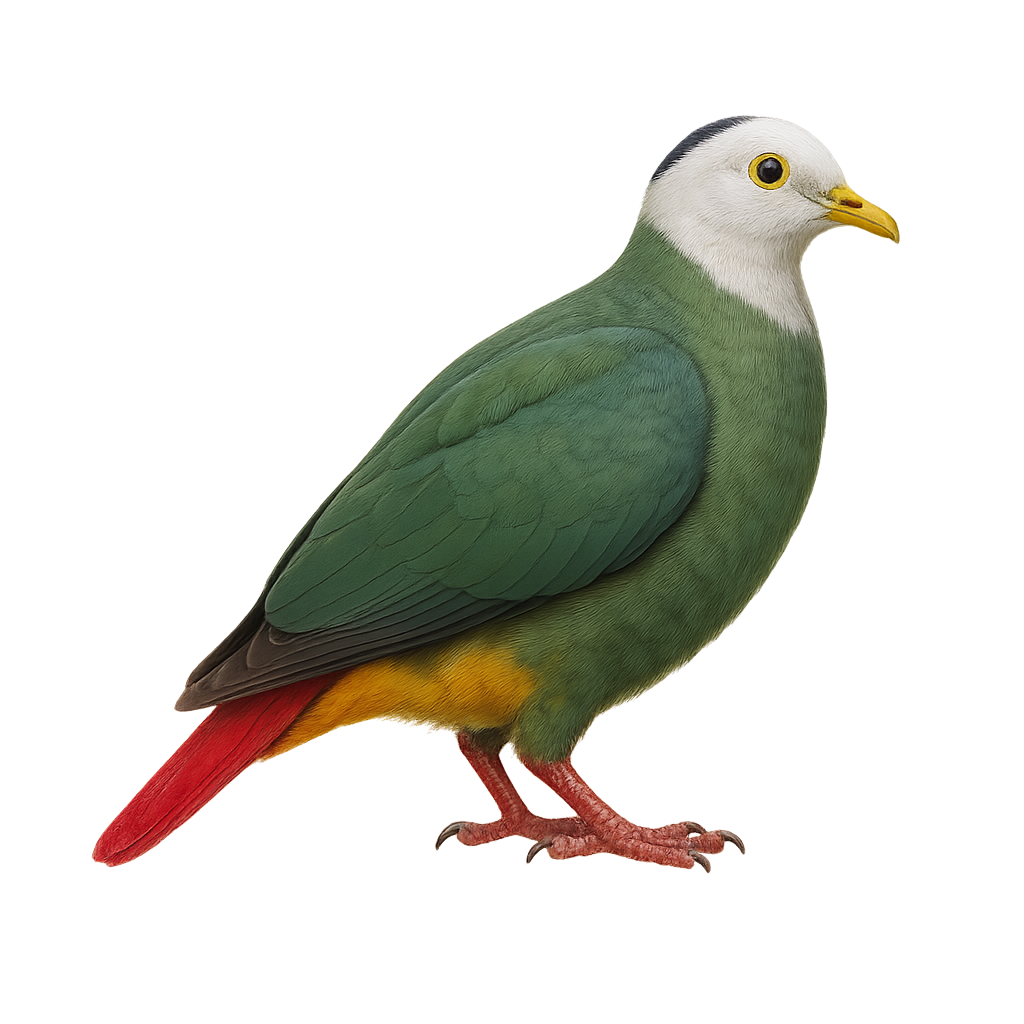The Brown-capped Whitestart, Myioborus brunniceps, is a small songbird in the Parulidae family. It is characterized by its dark brown head contrasting with a gray body and black wings. Its tail feathers are white, which is particularly noticeable in flight. It primarily inhabits mountain forests and wooded areas in South America, especially in Argentina and Bolivia. Its song is melodious and complex, often used to mark its territory. The Brown-capped Whitestart is a diurnal bird, active mainly in the morning and late afternoon. It feeds primarily on insects caught in flight or on leaves.
The Black-throated Blue Warbler is a small songbird from the Parulidae family, easily identified by the male's vibrant blue plumage, contrasting black throat, and white flanks. The female is more subdued, with olive tones and a distinctive white eyebrow. This species primarily inhabits deciduous forests and dense undergrowth in eastern North America. As a migratory bird, it winters in the Caribbean and Central America. Its melodious song and distinctive calls make it a favorite among birdwatchers. The Black-throated Blue Warbler feeds mainly on insects and larvae, which it skillfully catches while flitting among branches.
The Black-throated Gray Warbler, Setophaga nigrescens, is a small songbird in the Parulidae family. It is easily identified by its black head contrasting with white cheeks and a black throat. Its back is gray with black streaks, and its wings have two distinct white bars. This passerine measures about 12 cm in length and weighs between 8 and 10 grams. It primarily inhabits coniferous and mixed forests, but can also be found in shrublands and oak forests. A migratory bird, it breeds in the western United States and winters in the southwestern U.S. and Mexico. Its song is a high-pitched, rapid trill, often heard in spring.
The Blackpoll Warbler, Setophaga striata, is a small songbird in the Parulidae family. It is easily identified by its distinctive plumage: males have a black cap, white cheeks, and black streaks on their back. Females and juveniles are duller, with olive tones and less pronounced streaking. This migratory species travels long distances between its breeding grounds in the boreal forests of North America and its wintering areas in South America. It primarily feeds on insects, which it catches by flitting through foliage. The Blackpoll Warbler is known for its melodious song and high-pitched calls. Although its conservation status is concerning due to habitat loss, it remains relatively common within its range.
The Brown Pelican is a large seabird native to the American coasts, measuring between 100 and 137 cm in length with a wingspan of 200 to 228 cm. It is characterized by its brown-gray plumage, white head with a yellowish crown during the breeding season, and a long bill with an expandable throat pouch capable of holding up to 11 liters of water. This pelican is known for its dramatic fishing technique: diving from several meters high to catch fish, mainly sardines and anchovies. It inhabits coastal areas, estuaries, mangroves, and sandy beaches, nesting in colonies on islands or isolated areas. Although currently listed as Least Concern by the IUCN, the Brown Pelican experienced significant declines in the 20th century due to pesticide pollution, particularly DDT. Conservation efforts have led to population recoveries, but habitat degradation remains a concern.
The Blue-throated Piping Guan is a medium-sized bird belonging to the Cracidae family. It is primarily black with a distinctive blue face and white feathers on its wings. This bird is mainly found in the humid tropical forests of South America, particularly in Brazil, Colombia, and Venezuela. It is often seen in small groups or pairs, feeding on fruits, seeds, and occasionally insects. Although its habitat is threatened by deforestation, the Blue-throated Piping Guan is still relatively common in some areas. It plays a crucial role in seed dispersal, contributing to the health of its ecosystem.
The Black-throated Flowerpiercer is a small passerine bird belonging to the Thraupidae family. It is primarily found in the high-altitude forests of Mexico and Central America. This bird is recognizable by its black throat contrasting with its blue-gray plumage. It mainly feeds on nectar, which it obtains by piercing the base of flowers with its specialized beak, but it also consumes insects. The Black-throated Flowerpiercer is often seen in pairs or small groups. It is known for its territorial behavior, vigorously defending its territory against intruders. Although its habitat is threatened by deforestation, it is currently classified as of least concern by the IUCN.
The Black Flowerpiercer is a small bird from the Thraupidae family, primarily found in the Andes of Colombia, Ecuador, and northern Peru. It is distinguished by its glossy black plumage and slender, hooked bill, adapted for piercing flowers and feeding on nectar. Males and females are similar, although females may have slightly duller shades. This bird is often seen in humid montane forests and shrublands, where it plays a crucial role in pollination. Its song is a mix of high-pitched, melodious notes, often heard at dawn. Although relatively common in its natural habitat, it is rarely seen outside mountainous areas.
The Black Flowerpiercer is a small bird from the Thraupidae family, primarily found in the mountainous regions of the Andes. It is characterized by its black plumage with slightly lighter shoulders, which gives it its name. This bird is known for its unique flower-piercing behavior, using its specialized beak to access nectar. It mainly inhabits humid forests and shrubby areas at high altitudes. Although often seen alone or in small groups, it can sometimes be found in the company of other nectarivorous bird species. Its adaptability to various habitats and diverse diet make it an important component of the Andean ecosystem.
The Barbary Partridge is a terrestrial bird native to the mountains of North Africa and Western Asia. It measures about 30 cm in height and weighs between 300 and 500 g. Its plumage is characterized by brown and gray tones, with a distinctive "V"-shaped pattern on the chest. The Barbary Partridge primarily inhabits rocky, dry mountain habitats, where it feeds on seeds, roots, berries, and small insects. It is an excellent runner and, although capable of flying, prefers to move by running through the underbrush. This species is threatened in some regions due to excessive hunting and habitat loss, and it is protected in several countries.
The Hapalopsittaca amazonina, known as the Blue-fronted Parrot, is a fascinating bird native to the humid forests of South America. This medium-sized parrot features vibrant green plumage with a distinctive blue patch on its forehead. Its strong, hooked beak is adapted for cracking nuts and seeds, which make up the bulk of its diet. Social by nature, it often lives in noisy flocks, moving through the canopy in search of food. Although its habitat is threatened by deforestation, it remains relatively common in some areas. Its ability to mimic sounds also makes it a favorite among exotic bird enthusiasts.
The Blue-naped Parrot, or Tanygnathus lucionensis, is a colorful and fascinating bird native to the tropical forests of the Philippines. It is distinguished by its bright green plumage, characteristic blue nape, and robust beak. Measuring about 31 cm in length, it has a wingspan that allows it to move easily through the canopy. This parrot is often observed in small groups, emitting sharp calls. It primarily feeds on fruits, seeds, and flowers, playing a crucial role in seed dispersal. Although its natural habitat is threatened by deforestation, it sometimes adapts to agricultural areas. However, its population is declining, making it a conservation concern.
The budgerigar, Melopsittacus undulatus, is a small, colorful bird native to Australia. It is very popular as a pet due to its sociable nature and ability to mimic sounds. Measuring about 18 cm in length, it has predominantly green plumage with black undulations on its back and wings. Males and females can be distinguished by the color of their cere, blue in males and brown in females. In the wild, they live in large colonies and primarily feed on seeds. Highly adaptable, they can survive in various environments, from grasslands to semi-arid areas.
The Bufflehead is a small diving duck, easily recognizable by its distinctive plumage. The male features an iridescent black head with a large white patch behind the eye, while the female has a brownish head with a subtle white band. This duck primarily inhabits lakes and ponds in wooded regions of North America. It is often seen diving for small aquatic invertebrates and plants. Although it is a migratory bird, it is frequently observed in winter in more southern coastal waters. The Bufflehead is appreciated for its active behavior and quick dives, making it a fascinating subject for birdwatchers and photographers.
The Black-faced Spoonbill, Platalea minor, is a rare and iconic waterbird native to East Asia. It is distinguished by its pristine white plumage and its unique, flattened black spoon-shaped bill. Its black face, which gives it its name, contrasts with the rest of its body. This migratory bird primarily breeds in North Korea and China, wintering in Taiwan, Hong Kong, and Vietnam. It frequents coastal wetlands, estuaries, and salt marshes. Habitat destruction and pollution are the main threats to this vulnerable species. Conservation of its natural habitats is crucial for its survival.
The Black-capped Petrel, or Pterodroma hasitata, is a medium-sized seabird known for its distinctive plumage, featuring a black cap contrasting with its white belly. It is primarily found in the Caribbean and North Atlantic, often far out at sea. This petrel is an excellent glider, using air currents to travel long distances with minimal effort. It nests in burrows on steep slopes, often in inaccessible areas. Unfortunately, it is threatened by habitat loss and predation by introduced species. Conservation efforts are crucial for its survival.
The Black-backed Woodpecker, or Picoides arcticus, is a fascinating bird primarily inhabiting the boreal forests of North America. This woodpecker is easily recognizable by its glossy black plumage on the back and white flanks. It measures about 23 cm in length and has a powerful beak, ideal for digging into wood in search of insects. It primarily feeds on beetle larvae found under the bark of dead or dying trees. The Black-backed Woodpecker plays a crucial role in the forest ecosystem by helping control pest insect populations and creating cavities that serve as shelters for other species. Although generally discreet, its distinctive drumming can be heard from afar.
The Dendrocopos atratus, commonly known as the Black-and-white Woodpecker, is a medium-sized bird belonging to the Picidae family. It is characterized by its contrasting plumage, with a black back and white belly, and a red crown in males. This bird is primarily arboreal and feeds on insects by drumming on tree trunks. It is found in mountain forests, often at high altitudes. Its drumming is a characteristic sound of the forests it inhabits. Although discreet, it is sometimes observed feeding on the ground. The Black-and-white Woodpecker plays an essential role in the ecosystem by controlling populations of harmful insects.
The Black-cheeked Woodpecker is a colorful and fascinating bird found mainly in the tropical forests of Central America. Its head is adorned with bright red, contrasting with its black cheeks and pale yellow belly. This woodpecker measures about 18 to 20 cm in length and feeds primarily on insects, fruits, and nectar. It is often seen drumming on tree trunks to dislodge its prey. Although relatively common in its natural habitat, it is sometimes threatened by deforestation. Its call is a mix of sharp cries and rapid drumming, making it easily identifiable in the dense canopy.
The Black Woodpecker is a large bird from the woodpecker family, primarily found in deciduous and mixed forests of Europe, Asia, and North Africa. It measures between 45 and 50 cm in length, with a wingspan of 60 to 70 cm, and weighs between 250 and 300 g. Its plumage is entirely black, except for its ivory-colored bill. In females, a red patch adorns the top of the head, while in males, the red patch extends from the top of the head down to the nape. The Black Woodpecker is an excellent climber and a skilled driller, primarily feeding on insect larvae, arthropods, and sometimes small mammals found under tree bark. It prefers mature, well-established forests, where it creates large holes in search of food. While its population remains relatively stable, the Black Woodpecker is sometimes threatened by deforestation and habitat loss.
The Brown Shrike, or Lanius cristatus, is a medium-sized bird, about 20 cm long. It is recognizable by its brown plumage on the back and wings, with a lighter chest. Its head features a distinctive black mask around the eyes. This bird is often seen perched on branches or wires, scanning the ground for prey. Carnivorous, it primarily feeds on insects but can also capture small vertebrates. The Brown Shrike is migratory, breeding in northern Asia and wintering in Southeast Asia. It prefers open habitats such as grasslands and forest edges.
The Berthelot's Pipit is a small bird endemic to the Canary Islands and Madeira. It is characterized by its light brown plumage with darker streaks on the back and paler underparts. This bird is often seen in open habitats such as moorlands, dunes, and rocky areas. It primarily feeds on insects and small invertebrates caught on the ground. The Berthelot's Pipit is a sedentary bird, well adapted to its insular environment. Its population is stable, although confined to a limited territory. Protecting its natural habitats is crucial for its long-term survival.
The Cephalopterus glabricollis, commonly known as the Bare-necked Umbrellabird, is a fascinating bird from the Cotingidae family. It is primarily found in the humid forests of Costa Rica and Panama. This bird is notable for its large size and glossy black plumage. Males feature a spectacular crest and a bare neck that turns bright red during the breeding season. They produce deep, resonant sounds to attract females. The females, more discreet, have less striking plumage. The Bare-necked Umbrellabird is an arboreal bird, spending most of its time in the canopy searching for fruits, its main diet. Unfortunately, it is threatened by deforestation, which reduces its natural habitat.
The Brown-winged Schiffornis is a discreet and little-known bird belonging to the Tyrannidae family. It is mainly found in the humid tropical forests of Central and South America, where it blends in easily with its reddish-brown plumage. This bird measures about 16 to 18 cm in length and primarily feeds on insects caught in flight. It is often heard before being seen, thanks to its melodious and repetitive song. Although difficult to spot, it plays an important role in the ecosystem by controlling insect populations. Its ability to blend into its environment makes it fascinating for ornithologists and nature enthusiasts.
The Blue Finch, or Rhopospina caerulescens, is a medium-sized bird known for its blue-gray plumage and distinctive black beak. It primarily inhabits wooded areas and savannas in South America, particularly in Argentina, Brazil, and Paraguay. This bird is often seen in small groups or pairs, feeding mainly on seeds and insects. Its melodious song is a characteristic feature, used to mark territory and attract a mate. Although not considered threatened, deforestation and habitat loss pose potential threats to its populations.
The Bonelli's Warbler is a small songbird belonging to the Phylloscopidae family. It is mainly found in southern Europe and northern Africa. This passerine measures about 11 cm in length and weighs between 7 and 9 grams. Its plumage is primarily olive green on the upper parts and white on the underparts, with a distinctive pale wing bar. The song of the Bonelli's Warbler is a rapid, repetitive trill, often heard in oak and pine forests. It feeds mainly on insects and larvae, which it catches by flitting agilely among the branches. A migratory bird, it winters in sub-Saharan Africa before returning to Europe for the breeding season.
The Black-throated Wattle-eye, or Platysteira cyanea, is a small African bird with distinctive plumage. It features a black head contrasting with a white chest and gray back. Its eyes are surrounded by a reddish bare skin, adding to its unique appearance. This bird is primarily insectivorous, feeding on small insects caught in flight or on branches. It inhabits tropical forests and wooded savannas of sub-Saharan Africa, preferring dense areas where it can hide from predators. Known for its melodious songs, often heard at dawn and dusk, the Black-throated Wattle-eye is relatively common in its habitat but remains elusive and hard to spot.
The Brother's Batis is a small passerine bird belonging to the Platysteiridae family. It is mainly found in the forests and wooded savannas of East Africa, particularly in Tanzania and Kenya. This bird is characterized by its striking black and white plumage, with a distinctive black breast band. Males and females exhibit sexual dimorphism, with females having browner tones. The Brother's Batis is an active insectivore, often seen catching insects in flight or searching for them on branches. Its song plays a crucial role in territorial and courtship behaviors.
The Beautiful Fruit Dove, or Ptilinopus pulchellus, is a bird from the Columbidae family, known for its striking and colorful plumage. It displays a vibrant mix of green, yellow, and red hues, making it particularly attractive. This bird is primarily arboreal and feeds on fruits, playing a crucial role in seed dispersal in its natural habitat. It is endemic to the tropical forests of New Guinea, where it prefers dense and humid areas. Although its conservation status is currently "least concern," deforestation and habitat loss pose potential threats to its population.
The Black-naped Fruit Dove is a medium-sized bird, measuring about 24 cm in length. It is notable for its colorful plumage, with a black head contrasting against its bright green body. The wings show shades of yellow and blue, while the underside is paler. This bird is primarily frugivorous, feeding on various fruits and berries. It is often seen in small groups in humid tropical forests, where it plays a crucial role in seed dispersal. Although generally discreet, its soft and melodious call can be heard through the canopy. The Black-naped Fruit Dove is a resilient bird, capable of adapting to different habitats, but remains vulnerable to deforestation.


